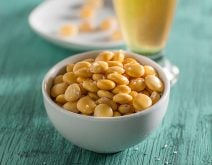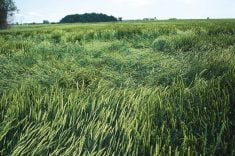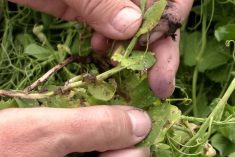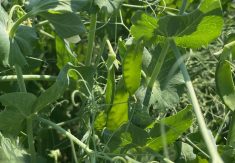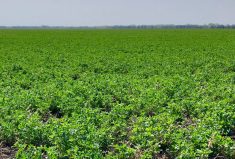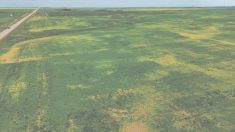How can producers make sure their on-farm trials produce useful results? Or perhaps a better question is whether growers can, or need to, run trials as rigorously as researchers?
Most farmers don’t have the time or patience to run the types of on-farm experiments that scientists do, says Ed Seidle. But that doesn’t mean they can’t pull together useful information.
The Seidle family run a pedigreed seed farm near Medstead, Sask. Ed Seidle is also an on-farm researcher and a honorary lifetime member of the Saskatchewan Institute of Agrologists. He has studied a wide range of agronomic topics in the field, including root maggots in canola, the economics of fungicide use in cereals, and, lately aphanomyces in peas. His office is filled with research papers, his own on-farm data, and cropping records going back decades.
Read Also

Cancer agency reclassifies another herbicide ‘probably carcinogenic’
The WHO’s cancer research agency has now put atrazine, a herbicide well known to corn growers, in the same potential-hazard category where the agency put glyphosate.
Side-by-side test strips need to be repeated, preferably four times, in the same location to be considered sound by the research community, says Seidle. Anything less is frowned upon, as it can produce misleading information, he says.
But that doesn’t mean that test strips are useless, Seidle says. Test strips can be useful when looking at factors such as maturity and straw strength.
Two sets of side-by-side test strips are “not bad,” Seidle says, especially if they’re repeated in several fields. Pull that information together and “it may be something you can go on,” he says. Strips don’t necessarily need to run the entire length of the field, he says, unless you’re comparing yield.
However, Seidle doesn’t recommend a couple of sets of test strips for issues such as disease tolerance. These trials require more scientific rigour, he says.
Farmers can also partner with agronomists. Ag retailers, farm groups, seed companies, and other organizations can run the same trials on several farms and pool the data.
“It would seem to me that you can make something of that,” says Seidle. But that data doesn’t necessarily represent what happens on a particular grower’s farm. Soil type, moisture, management, and microclimate can all come into play.
“I’m not saying it’s worthless but you’ve got to be a little careful with the results,” he says. Poor research can be worse than none at all, he adds.
Fungicide ROI
Between 1997 and 2010 the Seidle family studied fungicide effects on barley yields. Seidle notes that the term fungicide was hardly a word in most peoples’ vocabulary at that time.
Spray strips were replicated several times. The sprayer was a 100 feet wide, so the spray strips would be either 100 feet or 50 feet. Seidle says they would then leave a wide buffer before spraying another strip. He adds they watch wind direction closely to prevent the fungicide from drifting onto untreated checks.
To measure yield, Seidle used a square metre frame, and hand-harvested from four spots in each strip. Seidle says the return on investment was second only to the return on fertilizer. The treated checks often yielded 12 to 15 per cent better than the untreated, and sometimes as high as 35 per cent, with better kernel quality.
“Never did we have a situation where it didn’t pay,” he says.
Common sense tips
While most farmers don’t have the time or patience to run a four-year replicated trial, diligence and curiosity can go a long way on any farm.
Seidle has nearly 40 years of daily weather records for their farm. He’s compiled 30 years-worth of the mean temperature for each month into decade-long increments. The data shows that September is trending 1.5 C warmer on their farm. He’s also noticed that seeding and harvest months see more frequent precipitation than they used to.
Seidle has also been tracking May soil temperatures on their farm since 2003. Based on those averages, plus frost data, they wait until mid-May before seeding canola. Crops such as peas and oats can be sown earlier.
Farmers looking for better on-farm data can also look at improving soil sampling. In Seidle’s opinion, some of the soil testing is not done “in a manner that suits my science appetite. The results will only be as good as the sample.”
One common problem is an insufficient number of soil samples, Seidle says. Another problem is the small amount of soil sampled by small-diameter probes.
Soil characteristics can vary between and within rows. Seidle says there isn’t much research on it, but he is concerned that a small soil probe won’t draw a truly representative sample.
Seidle gets around this by using a narrow, flat spade to shave off a thin slice to the required depth. He then combines it with other samples from the same area, mixes them, and pulls a representative sample from the mix. Another solution would be to extract more samples with the probe, from both between and within rows, he says.
If farmers suspect soil quality differs between areas, they should test each area separately, he adds.
It’s also important to observe and keep track of details with any type of on-farm enquiry, Seidle says. He always carries a notebook and camera while checking crops. Depending on what he’s looking for, he might bring a sample pail as well.
Studying aphanomyces on the farm
Aphanomyces is a water mould that produces two types of spores. The active spores, known as zoospores, move through water in the soil and infect roots. The oospores rest in the soil for many years before releasing active spores that infect roots. Wet, compacted soils favour aphanomyces. Peas and lentils are susceptible to the disease.
Seidle suggests farmers track their rotations and yield, and refer to those records. For their own farm, he’s used these records to better understand what aphanomyces root rot is doing in each field. Observing visual symptoms can be very helpful because they are quite distinct.
One of Seidle’s fields saw an extra pea crop for certain reasons, but most were on a four-year or longer rotation. After several four-year rotations that included peas, some pea crops yielded poorly. There was no known reason for the yield decrease at that time. Fields that saw more frequent pea crops were more likely to see a yield slide. Ignoring that slide meant the next pea crop was more likely to be a wreck if the growing months were wet.
Seidle tells customers worried about aphanomyces to watch their pea yields. If the peas yield poorly for no known reason, it’s best to take at least a six-year break from aphanomyces-susceptible crops in that field, he says. That break should gradually drop inoculum levels.
Soil tests done in commercial labs don’t necessarily give farmers a good indication of whether or not they have aphanomyces in their fields, says Seidle.
Seidle has been screening pea varieties for tolerance on a piece of land he knows is heavily infested. On May 10, before seeding peas, he sent a soil sample to a commercial lab for aphanomyces testing, and it came back negative.
“I thought, wait a minute. This piece of land’s had peas on it for two years. It was bad before. It’s had two (susceptible) crops in succession. And it has no (detectable) aphanomyces?”
Ed Seidle seeded the trials anyway. On June 28, once the crop was growing, he sent in soil and plant material samples. Those samples came back positive. It seems that the test was able to detect new active spores but not the resting spores.
In July and November 2014, Seidle drew several soil samples from a field with a confirmed, severe aphanomyces infection. Seidle sampled soil from zero to 10 cm, 10 to 20 cm, and as deep as 50 to 60 cm.
Out of eight samples, two returned positive results, despite what should have been a high spore load. One positive sample was extracted from 8 to 12 cm on July 23. The other was sampled on November 5 at 10 to 20 cm. The other six were negative.
“It seems as though those soil tests are good for the active spores,” says Seidle. “But the hard, resting spores that are a little bit farther down, it doesn’t appear to pick those up.”
Seidle notes that research stations have other soil tests, but they’re not commercially available. He suggests doing a bioassay using infected plants to figure out whether they’re suffering from aphanomyces, fusarium root rot, or something else. Sample at the earliest signs of stunting or yellowing, he adds.
Aphanomyces tends to infect roots early in the season. Later on, other pathogens can obscure the aphanomyces infection. That means growers wondering whether a crop has aphanomyces should check the crop every few days, says Seidle. Observe waterways and traffic areas, he adds.
Watch what your plants are doing, he says. “That’s the best test.”
Much of the information on aphanomyces for this article was drawn from Ed Seidle’s paper “The Status of Aphanomyces Root Rot in Peas in North Western Saskatchewan.”




